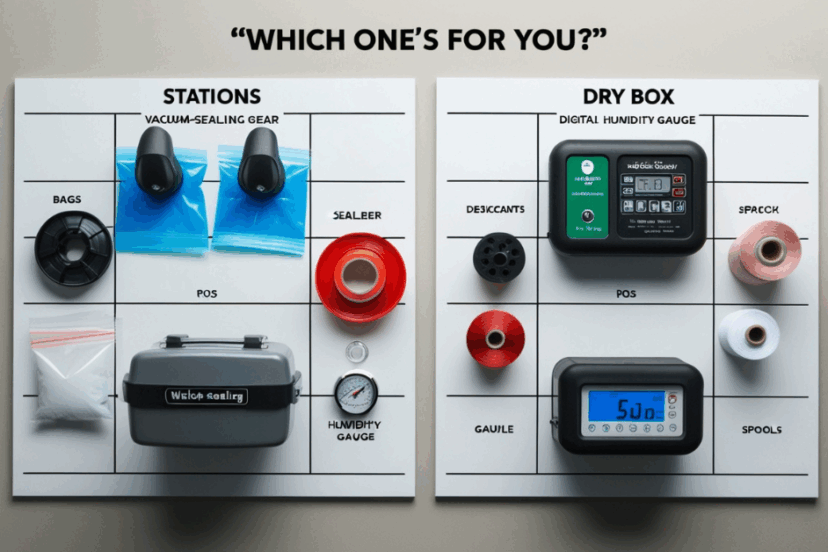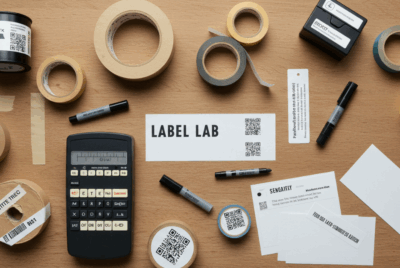What is the Best Way to Re-Seal Vacuum-Sealed Bags After Use?
Re-sealing vacuum-sealed bags properly after use is crucial to maintaining the moisture protection and integrity of the filament. If the bag is not resealed correctly, it can allow air and moisture to enter, potentially degrading the filament. Here’s how to do it effectively:
1. Use a Vacuum Sealer with a Re-Seal Function
- How It Works: Many vacuum sealers have a re-seal function that allows you to reseal the bag without removing air. This feature is perfect for when you’ve opened the vacuum bag to access filament and need to reseal it without losing the vacuum seal.
- Why It’s the Best Method: Using the re-seal function ensures the bag is airtight again without compromising the vacuum. This prevents moisture from entering, maintaining the protective seal for long-term storage.
- How to Do It:
- Place the remaining filament spool back in the vacuum bag.
- Align the bag edges properly.
- Use the re-seal function to create a new airtight seal.
- Benefit: This method is quick, easy, and effective for keeping the filament sealed in an airtight environment.
2. Use a Heat Sealer
- How It Works: If your vacuum sealer does not have a re-seal function, you can use a heat sealer. Heat sealers are designed to melt the edges of the bag together to create an airtight seal.
- Why It’s a Good Option: A heat sealer ensures that the bag is sealed securely, which helps maintain the quality of the filament. It works well for bags that have been opened and need to be resealed to protect the filament.
- How to Do It:
- Cut off any excess bag material from the initial seal.
- Place the filament spool back in the bag.
- Use the heat sealer to apply heat to the edges of the bag, melting them together and forming a tight seal.
- Benefit: This method is durable and ensures a strong, secure seal, which is ideal for long-term storage.
3. Manual Resealing (Without a Vacuum Sealer)
- How It Works: If you don’t have a vacuum sealer or heat sealer, you can manually reseal vacuum bags by rolling the open end tightly and using strong tape (e.g., packing tape or duct tape) to seal it.
- Why It’s a Temporary Solution: While this method is not as effective as using a vacuum or heat sealer, it can serve as a temporary solution to keep the bag as airtight as possible. However, this is less reliable because the seal may not be as tight, and air can still enter the bag.
- How to Do It:
- Roll the open end of the vacuum bag tightly to squeeze out as much air as possible.
- Use strong tape to secure the rolled end tightly, making sure the bag stays sealed.
- Benefit: This is an affordable, quick option if you don’t have access to a vacuum or heat sealer, but it’s not the most effective for long-term use.
4. Re-Vacuum the Bag with a Vacuum Sealer
- How It Works: If the original vacuum seal has been broken, you can re-vacuum the bag to remove the air and create a new airtight seal.
- Why It’s Effective: Re-vacuuming the bag ensures that all the air and moisture are removed, providing the best protection for your filament. This method is best used if the vacuum bag has a sealable edge that can be re-sealed after vacuuming.
- How to Do It:
- Insert the filament spool back into the vacuum-sealed bag.
- Place the open end of the bag into the vacuum sealer.
- Use the vacuum and sealing function to remove the air and reseal the bag.
- Benefit: Re-vacuuming provides the most secure seal, ensuring your filament is protected from moisture.
5. Double-Bagging for Extra Protection
- How It Works: If you want extra protection after resealing a vacuum-sealed bag, you can double-bag the filament by placing the vacuum-sealed bag inside another vacuum-sealed bag.
- Why It’s Useful: Double-bagging provides an additional layer of protection, especially if you are storing filament in challenging environments or over long periods. The second layer helps reduce the risk of moisture entering the first bag if it’s accidentally compromised.
- How to Do It:
- Seal the filament in the first vacuum-sealed bag.
- Place the first vacuum-sealed bag into a second vacuum-sealed bag and seal it again.
- Benefit: This method offers extra moisture protection and helps extend the filament’s shelf life.
6. Use Vacuum-Sealed Bags with Built-in Re-Sealing Features
- How It Works: Some advanced vacuum-sealed bags are designed with a built-in re-sealing feature, allowing you to simply close the bag without needing an external vacuum sealer.
- Why It’s Convenient: These bags are more convenient as they allow you to reseal the bag after opening it without needing additional equipment. The built-in sealing mechanism ensures that the bag is airtight.
- How to Do It:
- Place the filament spool back in the bag.
- Follow the instructions provided with the bag to seal it securely.
- Benefit: This method eliminates the need for a vacuum or heat sealer, making it easy to reseal the bag for quick storage.
Summary of the Best Ways to Re-Seal Vacuum-Sealed Bags After Use:
- Vacuum Sealer with Re-Seal Function: Best method for resealing without removing air. Quick and easy.
- Heat Sealer: Ideal for creating a secure, airtight seal, perfect for long-term storage.
- Manual Resealing: Quick and inexpensive, but less reliable than a vacuum or heat sealer.
- Re-Vacuuming the Bag: The most effective way to reseal a vacuum bag for maximum protection.
- Double-Bagging: Provides extra moisture protection by using two layers of vacuum-sealed bags.
- Vacuum-Sealed Bags with Built-in Re-Sealing Features: Convenient and easy resealing for quick storage.
Conclusion:
The best way to re-seal vacuum-sealed bags depends on your available tools and the level of protection you need for your filament. Vacuum sealers with a re-seal function or heat sealers offer the most reliable and secure seals, ensuring your filament remains protected from moisture. For occasional use, manual resealing or double-bagging can also be effective, though they’re not as secure for long-term storage.




